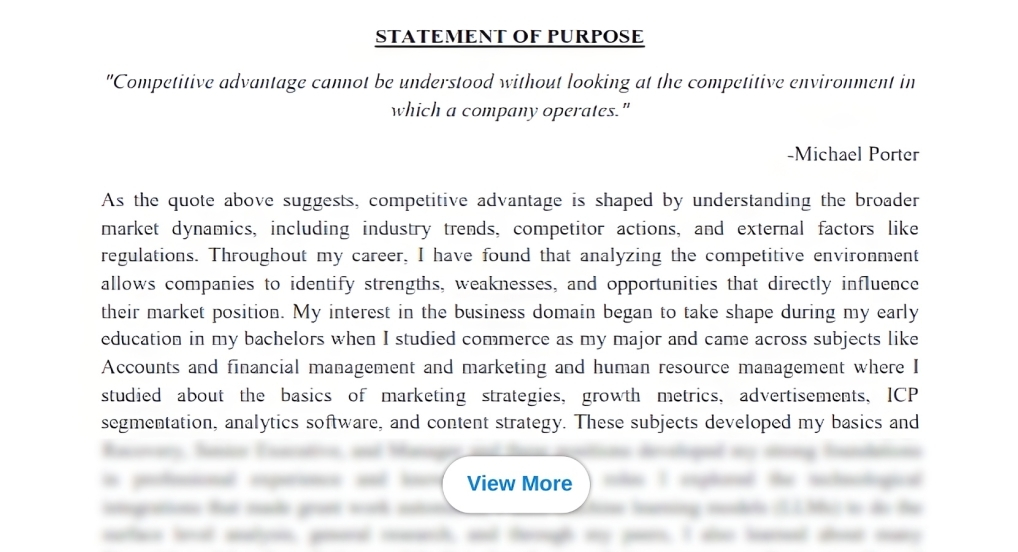



Writing a compelling Statement of Purpose is your golden ticket to studying in Canada. It’s more than just a document; it’s your chance to tell your unique story, showcase your passion and convince admissions officers that you belong at their institution. Discover the keys to unlocking your Canadian study dreams with our expert samples, format guides and essential tips to write SOP for Canada. Read below to learn how.

Table of Contents
A strong Statement of Purpose for Canada study permit application is vital because it is your main opportunity to communicate directly with the visa officer about your intentions and qualification. Here are some key reasons why it’s so important:
A Statement of Purpose matters for both getting into a Canadian university and getting a visa, but they focus on different things. Check out the section for details:
This Statement of Purpose is an academic document reviewed by university admission committees. It should detail:
The SOP for Canada student visa (a Study Plan) convinces the visa officer you'll go back home after school. It should include:
Take a look at the best SOP samples for Canada student visa for reference:
While both document outline your academic and professional background, the SOP for Canada student visa focuses on convincing immigration officers of your genuine intent to study and return home, while SOP for a university emphasize your academic potential and why you are an ideal candidate for their specific program. Look below for more better understanding of the difference:
| Aspect | University SOP | Student Visa SOP |
| Primary Audience | University Admissions Committee | Immigration, Refugees and Citizenship Canada (IRCC) visa officers |
| Main Purpose | To persuade the committee to grant you admission based on your academic fit and potential contribution to their community. | To persuade the visa officer that you are a genuine student, financially prepared, and intend to leave Canada after your studies. |
| Tone | More personal, persuasive, and may include anecdotes. | Formal, factual, and justification-focused. |
| Key Focus Areas | Academic potential, research interests, specific program alignment, and extracurricular involvement. | Reasons for choosing Canada over other countries, source of funding (financial stability), strong ties to your home country, and post-graduation plans (return intent). |
| Content Flexibility | Varies by university; some may ask specific questions or have word limits (typically 800-1000 words). | More standardized requirements; typically longer (1200-1500 words recommended) and must address potential visa concerns like study gaps. |
Writing a compelling Statement of Purpose is crucial for a Canadian student visa application. Adhere to the following guidelines to effectively communicate your study plan and intentions to immigration officers.
To write an impressive SOP for Canada student visa, you should be genuine, clear and organized by including a detailed explanation of your academic background, future goals, why you chose Canada and your financial plan. Ensure your SOP is original, error-free and showcase your unique passion and passion to your studies.
Here are some pointers to help you write an impressive Statement of Purpose for Canada student visa, look below:
The best SOP samples for Canada student visa includes an introduction, a detailed section on your academic and professional background, clear reasoning for your choice of course and university and a conclusion with your future plans. Maintain a formal, positive and clear tone, avoiding slang and vague language, to effectively communicate your genuine intention and prepare a concise, 1-2 page for essay with 1000-1500 words.
This structure helps the visa officer understand your journey and goals clearly. Refer to the following pointers for a simple pointer for an engaging format to guide you in writing your SOP for Canada study visa, look below:
Introduction:
Academic and Professional Background:
Reason for Choosing the Course and University:
Future Plans:
Conclusion:
Summing up, a well-crafted Statement of Purpose is essential for a successful application to Canada, serving as a powerful tool to persuade both university admissions committees and visa officers of your qualifications and authentic intent to study. The key to a strong SOP is understanding its dual purpose: to showcase your academic and professional potential to the university and to demonstrate your genuine commitment and future plans to the immigration authorities. However, if you find this process daunting, Gradding.com offer expert assistance and guidance to help you in SOP writing that can significantly increase your chance of success.
Aim for 800 to 1500 words for your SOP for Canada. The exact length depends on what the university and visa officer wants. Check their guidelines first to be sure.
Don't use the same SOP for different university or visa applications. Each one is different, and your SOP should show why you're interested in that specific program and university.
Yes, they do. The SOP for Canada is important. They use it to learn about you, why you want to study in Canada, and what you plan to do later. So, write something good and true.
Yes, you need an SOP even if you're applying through the Student Direct Stream. Keep it between 800 and 1200 words. Mention that you've already met the SDS needs, like paying tuition and having a GIC.
Yes, you can add social work or hobbies if they matter and help your application. Use them to show what you're good at, your personality, or why you care about your field. Explain how they make you special.
We are available in :
BangaloreAhmedabadJaipurHyderabadKeralaPuneChandigarhMumbaiGurgaonChennaiKolkataTrivandrumNoidaKochiCalicutKottayamKollamThrissurIndoreUdaipurdisclaimer:logos and other registered trademarks of universities used on this platform are held by their respective owners. Gradding does not claim ownership or association on them, and their use is purely for informational and illustrative purposes.
